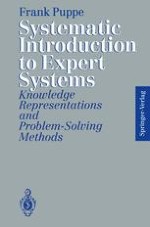1993 | OriginalPaper | Buchkapitel
Qualitative Multiple-Phase Simulation
verfasst von : Frank Puppe
Erschienen in: Systematic Introduction to Expert Systems
Verlag: Springer Berlin Heidelberg
Enthalten in: Professional Book Archive
Aktivieren Sie unsere intelligente Suche, um passende Fachinhalte oder Patente zu finden.
Wählen Sie Textabschnitte aus um mit Künstlicher Intelligenz passenden Patente zu finden. powered by
Markieren Sie Textabschnitte, um KI-gestützt weitere passende Inhalte zu finden. powered by
Qualitative multiple-phase simulation is a simplified form of numerical multiple-phase simulation. Unlike the latter it requires no global clock and cannot supply exact utilization statistics, but gives a state transition diagram as its result. A state is characterized by a set of simultaneous parameter values. The value range of the parameters is qualitative and is chosen so that each value has a special significance for the simulation, which is why they are often called “landmark values”. Any change of a value leads to a new state. Since value changes are no longer given by the advancing of a clock and numerical formulas, another concept must be introduced. It is based on the fact that in addition to the qualitative value of each parameter the trend, with the value range “increasing”, “constant” or “decreasing”, is also represented. A change of state occurs by replacing the value of a parameter with the trend “increasing” or “decreasing” by the next highest or lowest value, respectively. However, since there is no clock the time required for a change of state cannot be determined. On the other hand, state transition diagrams are relatively compact, and cyclic sequences of states can be recognized easily, which would be much more difficult with numerical multiple-phase simulation. Figure 32.1 shows the result of a qualitative multiple-phase simulation for a thermostat-controlled central heating system with a cyclic sequence of states (episodes 1 to 4).
